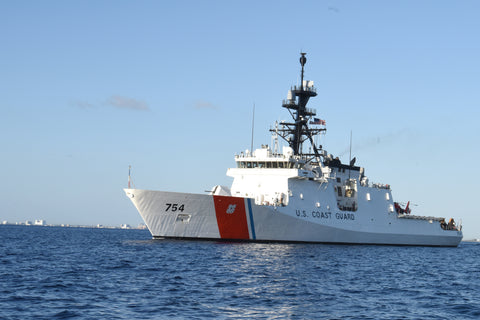Living on a Coast Guard Cutter: Embracing Life at Sea
April 24, 2024 
The image of the U.S. Coast Guard evokes a sense of duty, honor, and the perseverance of the human spirit against the raw power of the sea. While news headlines and movies often focus on dramatic rescues and daring operations, the daily life aboard a Coast Guard cutter is a tapestry of countless unseen efforts that form the backbone of the service's mission.
This blog post takes a look at what life is truly like for the men and women living aboard one of these maritime workhorses.
The Coast Guard Mission
Maritime interests are critical to our nation’s security, economy, and prosperity. Our waterways are precious environmental resources used for both commerce and recreation. The Coast Guard protects our seas, and protects us from the sea.
Helping mariners in distress is a core Coast Guard mission, with more than 3,500 lives and more than $75 million in property saved per year.
Introduction to the Coast Guard Cutter
The Coast Guard's fleet of cutters is as diverse as the missions they serve. From the legendary Eagle, a three-masted training vessel, to modern multi-mission cutters like the National Security Cutter, each ship is designed to carry out a specific set of responsibilities. But what truly sets these vessels apart is their endurance and adaptability. Cutters are more than just boats; they are floating communities, workplaces, and even, at times, an aegis for the United States.
A Day in the Life
A typical day aboard a Coast Guard cutter is anything but typical. Crew members live in tight quarters, necessitating a level of teamwork and camaraderie that is unmatched in most workplaces. The day usually begins early with reveille, followed by muster, and then a hearty breakfast. After that, operations commence, which could include searches for drug smugglers, ice-breaking in the Arctic, or sweeping for mines in strategic waters.
The Crew's Perspective
Our article explores the intricacies of the day-to-day routines on a Coast Guard cutter, covering their various duty stations, such as the bridge, engine room, and flight deck. With input from former Coast Guard personnel, we provide some insight into the roles of cutters.

The heart and soul of any Coast Guard cutter is its crew. Every service member and officer has a unique story to tell about their time on the water.
For example, while search and rescue personnel can easily talk about the rescues they’ve performed, Coast Guard cutter crews experience not just search and rescue, but a multitude of other missions. For example, during Operation Iraqi Freedom, a Coast Guard cutter operating under control of the U.S. Navy, guarded Iraqi Oil Platforms. A Coast Guard cutter not long ago also intercepted a drug-smuggling submarine and a dramatic video was captured of the Coastie jumping aboard the top of the sub in rough seas and pounding on it to get the drug smugglers to open the sub’s hatch.
A Coast Guard cutter can also perform routine patrols that deter narco-trafficking, but also assist in rescuing mariners and serve as a deterrent to pirates. A Coast Guard cutter also routinely interdicts migrants attempting to enter the United States illegally.
The Cutter
Modern cutters are marvels of engineering and are equipped with the latest technology to carry out their missions effectively. Did you know that at one point, Coast Guard cutters were equipped with anti-ship missiles like the Harpoon missile?
The term “cutter” identifies a Coast Guard vessel 65 feet in length or greater, with accommodations for a crew to live aboard. Major cutters like the national security cutter are capable of carrying multiple cutter boat types, including the over-the-horizon (CB-OTH-IV) rigid-hull inflatables, and long-range interceptors (CB-LRI-11).
Polar-class icebreakers also carry an Arctic survey boat, a polar variant of the CB-OTH-IV, and landing craft. Most cutters more than 200 feet in length are capable of accommodating helicopters. There are approximately 243 U.S. Coast Guard cutters.
The Cutter's Role in the Community
Coast Guard cutters are not just instruments of law enforcement and security; they play a vital role in the communities they serve. From providing humanitarian assistance to participating in local events, these vessels are ambassadors of goodwill.
For example, when an environmental disaster strikes, whether manmade or not, the Coast Guard cutter springs into action. When oil tankers run aground and begin to spill petroleum into the water, or a hurricane causes an oil platform offshore to leak, the Coast Guard steps in and conducts spillage suppression operations to help combat the spread of oil. This can be a serious contribution to a local community that might depend on the ocean or waterway to drive its economy.
Conclusion
The life of a Coast Guardsman on a Coast Guard cutter is one of service, sacrifice, and significance. From the routine to the remarkable, every moment at sea contributes to a legacy of protecting the American coastlines and waterways.
In wrapping up this narrative, hopefully you have gained a newfound appreciation for the men and women who call these the Coast Guard cutter their home. Hopefully you developed a deeper understanding of the critical role these vessels play in safeguarding our seas.
Through the facts presented here and a thorough exploration of the Coast Guard life, we hope you walk away with a sense of appreciation for the unsung heroes of our waters and a commitment to the spirit of service that defines the U.S. Coast Guard enterprise.
